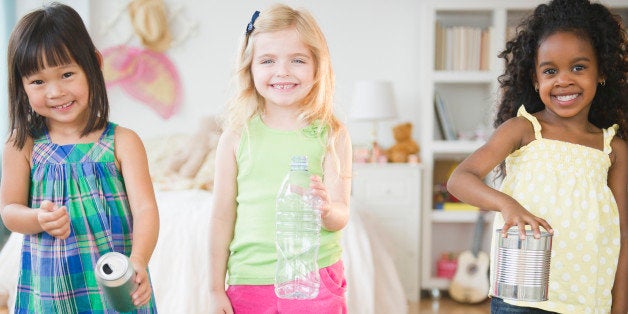
Most parents will say they want to raise a child who is intelligent, honest, kind, hard-working and independent. Topping that list is responsible. A Pew Research study found that 93% of parents want their children to be responsible. To encourage that quality, social and environmental responsibility must be taught. Without conscious awareness of one's habits, behavior becomes irresponsible. No age is too young to educate and empower children about our environment. In fact, the earlier, the better.
How do we start this conversation? Begin with the truth. Sugar coating minimizes the credit we give to children. Below is a guide to help you start these conversations.
1.Recycling is a temporary solution.
Most "recycling" is repurposing an item or "downcyling." For example, a water bottle is melted down and made into carpet or clothing creating an open-looped system. Eventually, this item will wind up in the trash. Recycling in the true sense of the word means converting that object into one of the same. An aluminum can is melted down and made into another aluminum can. In an ideal world, all products would be recycled using this close-looped system.
Not all recycling facilities have the capacity to recycle every type of plastic. Plastic bags, for example, jam up equipment and therefore will not be recycled if placed in your curbside collection bin. These must be taken to places that recycle bags separately. Most grocery stores have specifically designated bins for plastic bags.
The numbers inside the triangle on products are simply a coding system to help determine the type of resin. Many people confuse this triangle with the recycle symbol and assume that the product will be recycled. The best way to determine what is recyclable is to contact your local trash company and ask them specifically what their facility recycles.
2. Plastics do not biodegrade.
Plastic photodegrades, which means it breaks down into smaller and smaller particles called nurdles. Nurdles never fully go away. In the ocean, animals ingest these particles, mistaking them for food. Sea life become poisoned or form obstructions leading to their death. Plastics are around for a very, very long time. Besides contributing to our over populated landfills they release toxic chemicals which could wreak havoc over the long term. Bisphenol A (BPA) has been shown to interfere with the reproductive systems of animals, while styrene monomer is a suspected carcinogen.
Show children exactly what happens to plastic in the ocean. Google "albatross" and you will see many images of these birds cut open with plastic particles in their stomachs. We don't think twice about showing a violent cartoon or letting kids play with toy swords, but parents often resist showing a picture of a dead sea animal because it is too upsetting. Children should get upset. Through this displeasure, change occurs.
3.Most forests are not destroyed for wood items such as houses and paper.
Children know that paper comes from trees. They even know they should not waste or should recycle paper to "save" trees. What they don't know is the vast majority of forest destruction occurs due to farming. The United Nations estates that over 100,00 acres of rainforest are lost each day. At this rate, the remaining rainforests could be gone in the next 40 years. The destruction of these forest releases CO2 into the atmosphere. Additionally, the methane produced from large animals like cattle contribute even further to pollution. Which brings us to the next point.
4.The majority of CO2 occurs from human lifestyle.
Carbon dioxide is a greenhouse gas that is primarily responsible for global warming.
CO2 acts like a blanket, trapping heat in our atmosphere causing the earth's temperatures to increase. This is not a new phenomenon. However, since the Industrial Revolution these temperature increases are occurring at an alarming rate. This current warming trend is not natural.
While the United States represents 4% of the population, we produce 25% of CO2 pollution, more than any other country. Human activities, from transportation to the foods we eat, have caused this warming at an unprecedented rate. The impact is seen from extreme weather patterns, to health concerns, to ocean and animal life. In the next 25 years, the Arctic ice may cease to exist. Lifestyle habits must change to slow down this process.
5.They can make a difference.
With all this doom and gloom, it's important for children to realize they can create change. Even small changes can have a huge effect on the environment. Packing a trash-free lunch will save each student $250 and reduce 67 pounds of waste going into landfills. Children are little sponges absorbing information and eagerly wanting to make positive contributions. Empower them with the truth. Be honest, have these brutal discussions and see where their brilliant minds take them.
As we approach Earth Day, take a moment to read a book, go on a nature walk or create a picture to explain about our environment. Give children the knowledge to make daily changes that will have a lasting impact.
Dawn Wynne is a best-selling children's author, award-winning teacher, and certified health coach. Combing her love for the environment, passion for nutrition, and teaching talents she works with children and families to help them make healthy lifestyle choices. For information on her books visit her at www.dawnwynne.com.